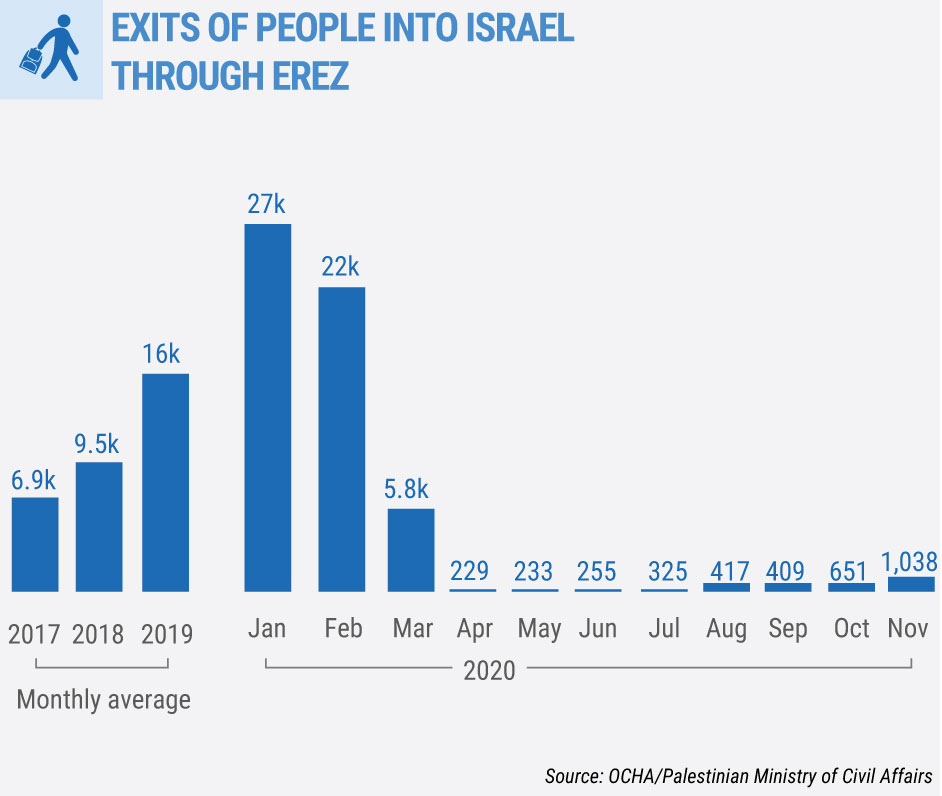Gaza Strip: Snapshot | November 2020
Monthly highlights
- Following the resumption of Palestinian-Israeli coordination the UN facilitation of the exit of patients has been terminated.
- The Rafah Crossing was opened for seven days, allowing over 8,000 people to cross in both directions.
- Increase in the number of Palestinians allowed through the Israeli-controlled Erez crossing.
- Concern over shortage of COVID-19 laboratory supplies.

Protection of civilians and casualties
- On two occasions, Palestinian armed groups fired three projectiles at Israel, one of which caused damage to a warehouse in Ashkelon city. Israeli air strikes that followed, hit and damaged military sites, as well as farmlands and greenhouses.
- On at least 34 occasions, Israeli forces opened warning fire towards Palestinians near the perimeter fence and off the Gaza coast, presumably to enforce access restriction, resulting in the injury of a fisherman. This represents a 56 per cent decline, compared with the monthly average of such incidents since the beginning of the year (78).
- Two boys were injured by explosive remnants of war (ERW). Since the beginning of 2020, two Palestinians, a child and an adult, have been killed, and eight others have been injured, including five children, by ERW.
Comprehensive data on conflict-related casualties is available at OCHA’s interactive database.

Access
- 2,110 crossings of people were recorded at the Israeli-controlled Erez Crossing in both directions. This is more than double the monthly average since the outbreak of COVID-19 (April-October), but only 4 per cent compared to January and February 2020, prior to the outbreak of the pandemic.
- In November, a total of 720 permit applications of patients to cross Erez for treatment in the West Bank or Israel were submitted to the Israeli authorities. Of those, 71 per cent were approved, while the remaining were either denied or received no answer by the time of the medical appointment. As of 23 November, the temporary mechanism operated by the World Health Organization (WHO) to facilitate the processing of patients’ exit permit applications has been suspended following the resumption of the coordination between the Palestinian and Israeli.
- After a month of closure, the Rafah passenger Crossing controlled by Egypt was officially opened for four days on 2 November and again for three days on 24 November in both directions. A total of 2,166 people entered Gaza, while 5,867 people exited. The latter represents an eight-fold increase compared with the monthly average of the crossing since mid-March.
- A total of 8,752 truckloads of goods entered Gaza via the Israeli-controlled Kerem Shalom Crossing and 980 via the Rafah crossing with Egypt. These represent a 9 and 22 per cent increase compared with the monthly average since the beginning of the year.
- A total of 259 truckloads were allowed out of Gaza via Israel, a slight increase compared with November 2019 (240). Of this month’s truckloads, 163 went to the West Bank, 95 to Israel and one to international markets. The latter truckload carried out olive oil, the first such export in many years. November marked the start of the export season for strawberries, the main cash crop in Gaza.
- In the context of COVID-19, from 1 November, people entering Gaza through the Rafah or Erez crossings, including international staff/foreign delegations, are not required to undergo home quarantine, provided that they produce a negative PCR test result taken within 48 hours prior to entry (for further information about COVID-19, see OCHA’s dedicated webpage).
Comprehensive data on Gaza crossings is available at OCHA’s interactive database.




Services, Livelihoods and Shelter
- The average electricity supply reached 14 hours a day, the highest such figure since May. This is attributed to weather-related decrease in demand.
- The volume of desalinated water produced in November slightly increased compared with October and has remained one of the highest recorded since the beginning of the year. This is attributed to the improved power supply.
- The pollution level of the wastewater discharged to the sea decreased by about 32 per cent, compared to October, due to the resumption of works at the Gaza wastewater treatment plant, previously halted for cleaning and rehabilitation works, ahead of winter.
- Amidst a tripling of the number of active COVID-19 cases during November, the local authorities in Gaza have warned about chronic shortages of related laboratory supplies, particularly testing kits, as well as oxygen supply for patients at the dedicated the European Hospital (for further information about COVID-19, see OCHA’s dedicated webpage).
An interactive database on electricity supply in Gaza is available at OCHA’s website.











